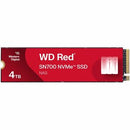Description
WD Red SN700 WDS400T1R0C 4TB Solid State Drive - M.2 2280 Internal - PCI Express NVMe (PCI Express NVMe 3.0 x4)
The WD Red SN700 4TB NVMe SSD is engineered to deliver dependable, high-performance storage for NAS environments where reliability, steady throughput, and large capacity matter most. Built for multi-user access and demanding workloads, this M.2 2280 drive blends enterprise-grade endurance with the speed of PCIe NVMe to accelerate media libraries, virtual machines, backups, and data-heavy applications in small to mid-size business NAS setups. Whether you’re expanding a home lab, upgrading a business NAS, or creating a robust caching layer for data-intensive workloads, the WD Red SN700 is designed to keep data flowing smoothly, even under sustained load. Its NAS-optimized design prioritizes steady performance, efficient power usage, and consistent reliability, helping to minimize downtime and maximize uptime for always-on environments.
- The WD Red SN700 delivers strong NVMe performance optimized for NAS workloads, leveraging a PCIe Gen3 x4 interface to deliver fast sequential reads and writes that help media streaming, backups, and database operations run more smoothly in shared storage environments.
- With a capacious 4TB capacity, this drive provides ample space for large media libraries, virtual machine images, databases, and backup archives. The substantial capacity reduces the need for frequent expansion, simplifies data organization, and supports more aggressive data retention policies within your NAS ecosystem.
- Designed for reliability in always-on NAS deployments, the SN700 uses firmware tuned for multi-user concurrency and sustained workloads. It’s built to maintain consistent performance over time, helping to prevent the dips in throughput that can occur when NAS devices handle many simultaneous users or streams.
- The compact M.2 2280 form factor makes the SN700 easy to slot into compatible NAS devices, PCIe-enabled motherboards, or certain high-density storage enclosures. This form factor supports compact builds and provides a versatile upgrade path for systems that leverage NVMe caches or direct NAS storage.
- Engineered for durability and long-term use, the WD Red SN700 emphasizes reliability in 24/7 environments. It’s a solid choice for small businesses and power users who require steady performance, robust data protection features, and quiet, energy-efficient operation in a NAS or server setting.
Technical Details of WD Red SN700 WDS400T1R0C
- Capacity: 4TB
- Form Factor: M.2 2280
- Interface: PCIe Gen3 x4 NVMe
- NVMe Protocol: NVMe 1.3/1.4 family (designed for high-throughput NVMe workloads)
- Sequential Read: up to 3,400 MB/s
- Sequential Write: up to 3,000 MB/s
- Target Workloads: NAS, multi-user access, media streaming, backups, and cache acceleration
- Durability: Built for reliable, 24/7 operation in NAS environments with firmware tuned for NAS workloads
How to Install WD Red SN700
Before you begin, verify that your NAS or system supports an NVMe M.2 drive in an M.2 2280 slot and that any required firmware updates are available from your device manufacturer. Power down the device and unplug it from power before handling components. Remove the cover or access panel to reach the M.2 slot, then follow these steps for a proper installation:
Step 1: Locate an available M.2 2280 slot aligned with PCIe NVMe on your NAS or motherboard. If your enclosure requires, ensure a compatible heatsink or thermal solution is in place, as sustained NAS workloads can generate heat that affects performance. Step 2: Align the SN700 with the notch in the slot and insert it at a slight angle, typically around 30 degrees, ensuring the gold-finger contacts are fully seated. Step 3: Lower the drive into place and secure it with the mounting screw provided by the device chassis. If your NAS has a tool-less design, follow the manufacturer’s instructions to lock the drive in without screws. Step 4: Reassemble the enclosure, connect power, and boot the system. Step 5: Enter the NAS’ management interface and recognize the new drive. If needed, initialize the drive, set up a RAID pool, and configure NAS-specific features such as caching, SMART monitoring, and data protection policies. Step 6: Update the drive firmware if a newer version is available and verify that the NAS recognizes the 4TB capacity. If you’re using this SSD as a cache or acceleration tier, configure its role within the NAS software to optimize reads and writes for your most active data. Step 7: Monitor performance and temperatures during initial workloads to confirm stable operation, and consider enabling thermal throttling alerts or a heatsink if you anticipate heavy sustained usage. Following these steps helps ensure a smooth installation with optimal performance and reliability for NAS-based workloads.
Frequently asked questions
-
Q: Is the WD Red SN700 specifically optimized for NAS environments?
A: Yes. The WD Red SN700 is designed with NAS workloads in mind, offering firmware and endurance characteristics that support multi-user access, continuous operation, and stable performance in shared storage setups.
-
Q: What form factor and interface does this drive use?
A: It uses an M.2 2280 form factor with a PCIe Gen3 x4 NVMe interface, making it suitable for compatible NAS devices and PCIe-enabled systems that support NVMe storage.
-
Q: What capacity is available in this model?
A: The WD Red SN700 in this variant is 4TB, offering ample space for media libraries, backups, databases, and VM images within a NAS environment.
-
Q: Can I use this drive in a desktop PC or only in NAS?
A: While designed for NAS use, the drive is compatible with devices that have an NVMe-enabled M.2 slot. Always verify compatibility with your device manufacturer and ensure you have adequate cooling for sustained workloads.
-
Q: Are there any special cooling or installation considerations?
A: For sustained NAS workloads, consider adequate airflow and, where appropriate, a heatsink or active cooling to maintain steady performance. Ensure the device’s firmware is up to date to maximize reliability and compatibility.
Customer reviews
Showing - Of Reviews


